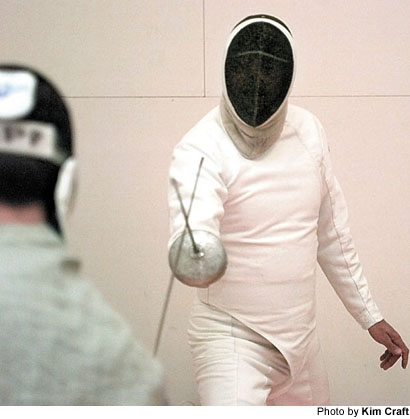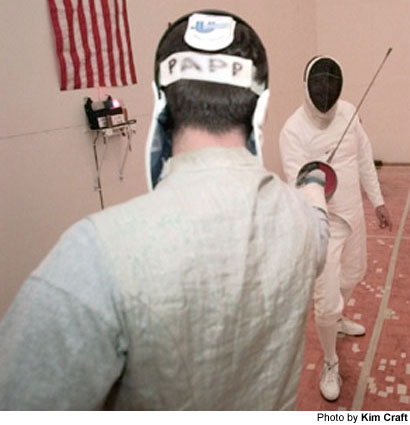
December 14, 1999 — The welts on my right shoulder told me that I should be thankful my fencing lesson came on the verge of the 21st century and not during the 16th.
For if the latter was the case, I’d likely be writing this from my grave.
The modern-day Olympic sport of fencing has its roots in the unarmored rapier dueling of Elizabethan Europe, which was all the rage among gentlemen and generals alike.
It was a means of settling disputes, where who was wrong and who was right mattered much less than who was dead and who was alive after it all went down.
With modern fencing, the thrill of one-on-one combat lives on — just without all of that blood and gore. We wouldn’t want to soil those nice white uniforms, would we?
The red marks on my shoulder came courtesy of Gainesville fencer Mark Papp, who discovered the fighting sport eight years ago while visiting the Georgia Renaissance Fair.
He liked it — a lot. He starting training regularly with Wolfgang Finck of the Fayette Fencing Academy in Fayetteville. He had a high-tech fencing strip installed in his home.
Fencing seemed to click with Papp’s personality. He’s an aggressive individualist, a shrewd businessman who last year sold his poultry company — Almark Inc., which sells peeled, hard-boiled eggs in bulk to the food services industry — and retired as a 44-year-old bachelor.
Ah, the hard-boiled egg. So simple. So lucrative?
“It was kind of an odd niche,” chuckled Papp, now 45.
Papp approached fencing with the same drive and determination that led him to an early retirement. Before long he was winning tournaments throughout the Southeast. Last year, he qualified for the World Cup in Montreal.
“Fencing is not just a physical sport, it takes a high degree of thought,” Papp explained as we sat in his wood-walled study, the mounted heads of slain animals looking on. “It’s called the physical game of chess, because every move has a countermove.”
It was down in Papp’s “fencing lair” that I learned these countermoves must be performed quickly and precisely. Failure to do so results in red marks on your shoulder, or wherever else Papp decides to stick you with his epee, the long, thin fencing weapon with a triangular blade and a large bell guard in front of the handle.
Papp’s fencing strip — actually a section of the regulation racquetball court inside his palatial Lake Lanier home (that’s a lot of hard-boiled eggs) — has all of the bells and whistles a tournament strip does. Our epees, with flattened spring-loaded tips, were wired to sound a tone and light a lamp when a touch was recorded.
But even with all of the technology, fencing still comes down to the same basic premise that existed hundreds of years ago. Man versus man. Skill versus skill. Cunning versus cunning.
The great thing about fencing, however, is that an unskilled man with very little cunning can thoroughly enjoy the sport, and not die trying it.
After a brief primer on basics — the en garde (the prepared stance), the parry (a defensive action), the riposte (a counterattack), the lunge (the most common attack) — we got right into it.
“Ready?” Papp asked me as we stood face-to-face, epees raised. I nodded. “Fence.”
And, with that, our battle began.

Papp was the obvious leader in this tempestuous dance up and down the narrow strip. I attempted to parry his often sudden and adroit attacks. If unsuccessful, he would step back and wait, wait for me to become impatient, wait for me to make a hasty advance, wait until he could score the easy touch.
I tried to read his eyes, but they were hidden behind his mask. I tried to read his moves, but they were designed to deceive.
Fencing is a sport of subtle and small moves. It is also a sport of intense mental and physical stamina.
“Are you starting to feel a workout?” Papp asked me after a few bouts. “If we were really going at it, the sweat would be falling off of you.”
“It already is,” I said, wiping my brow.
“Another one?”
“Yeah,” I nodded. “Sure.”
“Ready? Fence.”
Something about the sound of metal clashing against metal makes my heart race. It makes me feel alive.
I wear the red marks on my shoulder with honor.
